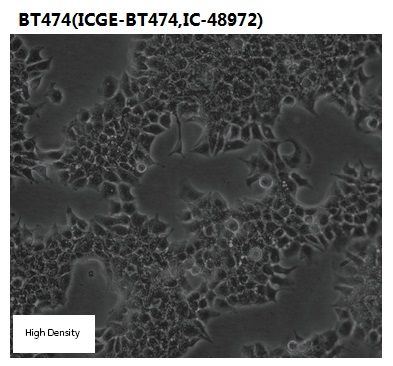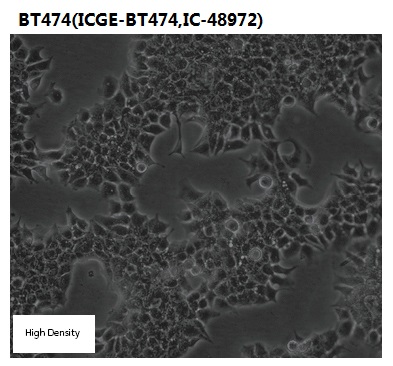


| Organism | Homo sapiens, human |
|---|---|
| Tissue |
mammary gland; breast/duct
|
| Product Format | frozen |
| Morphology | epithelial |
| Culture Properties | adherent, patchy (The cells form adherent patches of epithelial-like cells The patches are compact multilayered colonies that rarely become confluent) |
| Biosafety Level |
1
Biosafety classification is based on U.S. Public Health Service Guidelines, it is the responsibility of the customer to ensure that their facilities comply with biosafety regulations for their own country. |
| Disease | ductal carcinoma |
| Age | 60 years adult |
| Gender | female |
| Ethnicity | Caucasian |
| Storage Conditions | liquid nitrogen vapor phase |
| Karyotype | The cell line is aneuploid human female (XO usually), with most chromosome counts in the hypertetraploid range. Several chromosomes (N11, N13, and N22) are absent, and others are clearly under-represented (N9, N14, and N15) with respect to the other normal chromosomes. Chromosome N7 tends towards over-representation in several karyotypes. Some of the missing normal chromosomes are represented by their involvement in the nine stable marker chromosomes: der(14)t(14;?)(q32,?), unknown, iso(13q), der(6)t(6;7)(q21;q21), der(11)t(11;?)(14;?), del(11)(p11), unknown, unknown, der(2)t(2;?)(p21;?). Several of the latter were reported by E. Lasfargues, et al. Ref |
|---|---|
|
|
|
| Derivation |
The BT-474 line was isolated by E. Lasfargues and W.G. Coutinho from a solid, invasive ductal carcinoma of the breast.
|
| Clinical Data |
60 years adult
Caucasian
female
|
| Tumorigenic | Yes |
| Effects |
Yes, in Amsterdam/IMR rats with regression in 10 days
Yes, in nude mice
|
| Complete Growth Medium |
The base medium for this cell line is ATCC Hybri-Care Medium, Catalog No. 46-X. Hybri-Care Medium is supplied as a powder and should be reconstituted in 1 L cell-culture-grade water and supplemented with 1.5 g/L sodium bicarbonate. To make the complete growth medium, add the following components to the base medium: fetal bovine serum to a final concentration of 10%. |
|---|---|
| Subculturing |
HTB-20 recovers slowly from cryopreservation. It may take two to four weeks for the cells to reach 70-80% confluence in a T-75 flask after thaw. Remove medium, and rinse with 0.25% trypsin, 0.53 mM EDTA solution. Remove the solution and add an additional 1 to 2 mL of trypsin-EDTA solution. Allow the flask to sit at room temperature (or at 37��C) until the cells detach. Add fresh culture medium, aspirate and dispense into new culture flasks. Corning® T-75 flasks (catalog #430641) are recommended for subculturing this product.
Subcultivation Ratio: A subcultivation ratio of 1:2 to 1:3 is recommended
Medium Renewal: 2 to 3 times per week
|
| Cryopreservation |
Freeze medium: Complete growth medium, 95%; DMSO, 5%
Storage temperature: liquid nitrogen vapor phase
|
| Culture Conditions |
Temperature: 37��C
Atmosphere: air, 95%; carbon dioxide (CO2), 5% |


